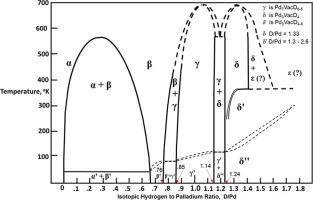Materials Science and Engineering: B ( IF 3.9 ) Pub Date : 2020-06-22 , DOI: 10.1016/j.mseb.2020.114600 M.R. Staker

|
The addition of three superabundant vacancy (SAV) phases, γ (Pd7VacD6–8), δ (Pd3VacD4 – octahedral), and δ′ (Pd3VacD4 – tetrahedral) to the palladium – isotopic hydrogen phase diagram was recently reported [1]. Also, in that study, production of excess heat from a nuclear source during electrolysis in heavy water indicated portions of the palladium (Pd) – deuterium (D) specimen were in the ordered δ phase, while a drop in resistance of the Pd during excess heat, with an increase in temperature, indicated portions of the specimen had shifted to the ordered δ′ phase. Both δ and δ′, create intersecting channels along the edges of the unit cells which are in effect long strings of Pd lattice vacancies for fast electron transport or a deuteron resonance condition. At high D/Pd ratio, the Pd-D alloy can be multiphase. An estimate of the volume fraction (fv) of δ phase is made from the amount of nuclear energy measured. An estimate of fv of δ′ is made from the measurement of the change in resistivity of the overall multiphase Pd-D alloy using the rule of mixtures. Both δ and δ′ have low volume fractions with fv(δ) ≈ 0.03% and fv(δ′) ≈ 5%. These experimental measurements suggest that δ is the nuclear active environment (NAE) for low energy nuclear reactions (LENR) while δ′ is likely a high conducting state (phase). Which interstitial site (octahedral or tetrahedral) is occupied by isotopic hydrogen would determine whether the phase is nuclear active or highly conductive. These two phases are distinct and can coexist as minor volumetric components (phases) because they are both of low volume fractions, share the same composition (arrangement of Pd and lattice vacancy sites, and can also share the same D/Pd ratio), and result from hydrogen-induced vacancy formation. Thus, portions of the specimen can be producing nuclear energy (excess heat) while other portions can be highly conductive.
中文翻译:

估计过剩空位相的体积分数及其在钯-同位素氢系统中低能核反应和高电导率中的潜在作用
添加了三个超丰满空位(SAV)相γ(Pd 7 VacD 6-8),δ(Pd 3 VacD 4 –八面体)和δ'(Pd 3 VacD 4-四面体)到钯-同位素氢相图最近已报道[1]。此外,在该研究中,在重水中进行电解过程中核源产生的多余热量表明,钯(Pd)-氘(D)标本的部分处于有序δ相,而过量时Pd的电阻下降随着温度的升高,加热表明样品的指示部分已移至有序的δ'相。δ和δ'都沿单位晶胞的边缘产生相交的通道,这些通道实际上是Pd晶格空位的长串,用于快速电子传输或氘核共振条件。在高D / Pd比下,Pd-D合金可以是多相的。体积分数(f vδ相是由测得的核能得出的。δ'的f v的估计是通过使用混合法则对整个多相Pd-D合金的电阻率变化进行测量而得出的。δ和δ'的体积分数都很低,f v(δ)≈0.03%和f v(δ')≈5%。这些实验测量结果表明,δ是低能核反应(LENR)的核活性环境(NAE),而δ'可能是高传导态(相)。同位素氢占据哪个间隙位点(八面体或四面体)将确定该相是核活性的还是高导电的。这两个阶段是不同的,并且可以作为次要体积成分(相位)共存,因为它们都低体积分数的,共享相同的组合物(Pd和晶格空位位点的排列,并且可以还共享相同的d /钯比),和氢诱导空位形成的结果。因此,标本的某些部分可能产生核能(多余的热量),而其他部分可能具有很高的导电性。











































 京公网安备 11010802027423号
京公网安备 11010802027423号